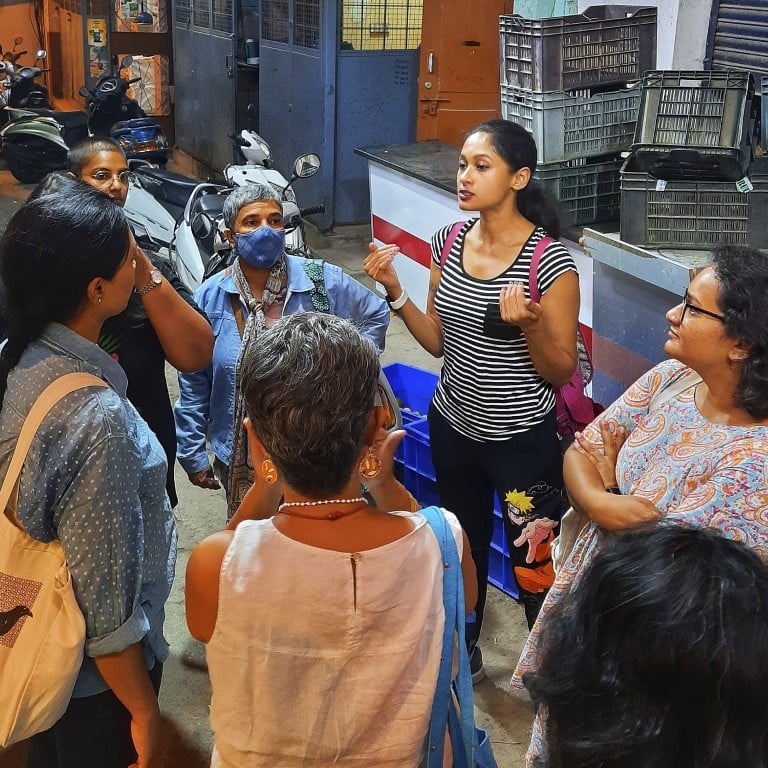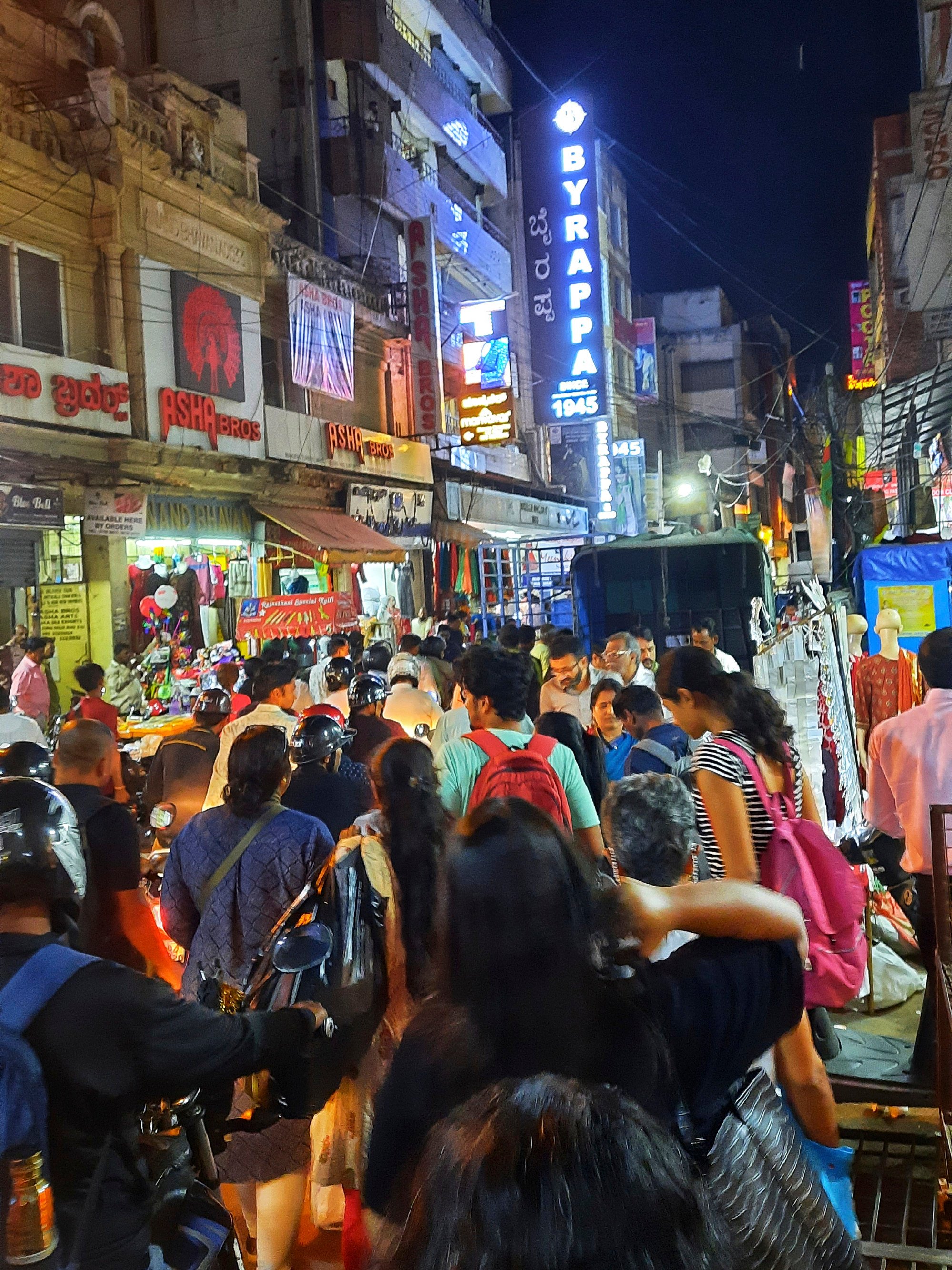
How night walks for women in India are allowing groups to tread fearlessly on streets most would otherwise avoid after sundown
- Night walks for women by women are a new initiative in Bangalore that sees groups traverse the busiest streets where alone the risk of harassment would be high
- The founder of the tour group that runs the walks says they wanted women to be able to reclaim public spaces and have fun while doing it
On a warm, late March evening, in fading twilight, a dozen women gather outside the Central College metro station in the heart of the Indian city of Bangalore. Other than two pairs of friends, we are strangers.
But introductions are made and soon all is excited anticipation and a will to conquer. As pompous as that sounds, a group of women setting out for a night walk on the streets of Bangalore’s Chickpete area, a crowded, congested traditional business district, is a rare occurrence.
In general, women avoid Indian streets at night, especially if alone and in busy areas, because of the harassment they are likely to encounter: anything from being brushed against and deliberately crowded out to being purposely bumped into or grabbed.
Gully Tours is the boutique experiential tour company behind our “Pete by Night – For Women by Women” experience. “It’s not unsafe,” says Parvathi Bhat Giliyal, lead of the company’s heritage and food walking tours, to the assembled women. “Just be on your guard. Try and stay together and we will have a good time.”

We set off in twos and threes, dodging foot and vehicular traffic. As we cross into Chickpete, the chaos intensifies. The roads are filled with jostling pedestrians, bicycles, vehicles, vendors and people pushing carts of all sizes. It is noisy, dusty and humid.
By now, the group is in single file, each woman trying to keep the one in front in sight. It helps that we are carrying large, bright tote bags that are easily visible; it helps further that they are filled with goodies from women entrepreneurs, all collaborators of Gully Tours.
See a side of Sri Lanka few tourists do at a sustainable eco-retreat
Parvathi breaks the group in gently. She leads us into small patches of sanity: first a deserted courtyard, to point out architectural styles that have been added over the years, and then the premises of the State Bank of India, housed in a 110-year-old stone mansion that used to be a lunatic asylum.
Back on the street and heading further into Chickpete, it feels as though we’re entering controlled bedlam. This is a traditional business district with a history going back nearly 500 years, all the way to the city’s founder, Kempegowda. Bangalore might be known as a smart tech city, but Chickpete is frozen in time.
As we head deeper into the maze, we discover alleys that are barely wide enough for a two-wheeler to pass through. Narrow buildings sit cheek by jowl, many fronted by business establishments with living quarters behind.

Even the main thoroughfares, few and far between, where once horse-drawn carriages and bullock carts clattered through, are broad enough only for a car or a small truck.
Off the main roads, goods are transported by hand or on little pushcarts or modified bicycles. As we dodge and weave around these obstacles, Parvathi stops frequently to narrate a story (such as the legend of Kempegowda setting loose four oxen in 1537 to see where they would stop, thus marking the boundaries of the new city) or a historical titbit (Bangalore was the first city in Asia to get electricity). She also points out various architectural styles (art deco, Bauhaus, colonial).
As darkness falls, the streets become noisier and more crowded.

On OTC Road, possibly the busiest stretch, Parvathi issues an extra warning to be vigilant about personal space and belongings. We frequently lose sight of each other and get jostled by men on foot and on slow-moving two-wheelers.
Terse words are exchanged in a couple of instances. But it also feels safe to be in a group, to know that there’s support.
Just before it all gets too overwhelming, we turn a corner. “You have survived the most crowded stretch of Bangalore. Give yourselves a pat on the back,” Parvathi says.

And it does feel like a sense of achievement.
“We wanted women to feel safe as a community, to be able to reclaim public spaces and also have fun while doing it,” Gully Tours founder Vinay Parameshwarappa will tell me later.
Aptly, the Chickpete tour was launched on March 8, International Women’s Day. Another night walk for women, in Cantonment, the colonial part of Bangalore, was launched a few days later, and more are to come, Parameshwarappa says.

The plans are optimistic in the face of a dismal national record: crimes against women in India have risen alarmingly in recent years, with more than 425,000 recorded by the government in 2021. India ranks 148 in a list of 170 countries in the US-based Women, Peace and Security Index.
Back on the walk, as we wind through the streets, we hear handlooms and see bales of saris being carried to stores. We pass colourful old shops – in which generations of women have bought saris for weddings, festivals and daily wear – jewellers, and traders of dry fruit and yarn.
We pass the red crumbling remnants of a circle where Kempegowda is supposed to have set his oxen free, and the stark-white, century-old Rice Memorial Church. Street food vendors fill the air with aromas.

We stop to eat vada pav (spicy mashed potato fritter in a square bun) and masala dosa (rice-lentil pancake with spicy filling accompanied by coconut chutney), drink thandai (cold milk with ground nuts, spices and poppy seeds) and finish it all off with jalebi (a deep-fried floury circle soaked in sugar syrup).
After two-and-a-half hours we are back at the metro station, saying our goodbyes and giving each other promises to keep in touch.
For 150 minutes, a dozen women, mostly strangers, were united in the simple belief that walking freely on our city’s streets should not be a male preserve.

